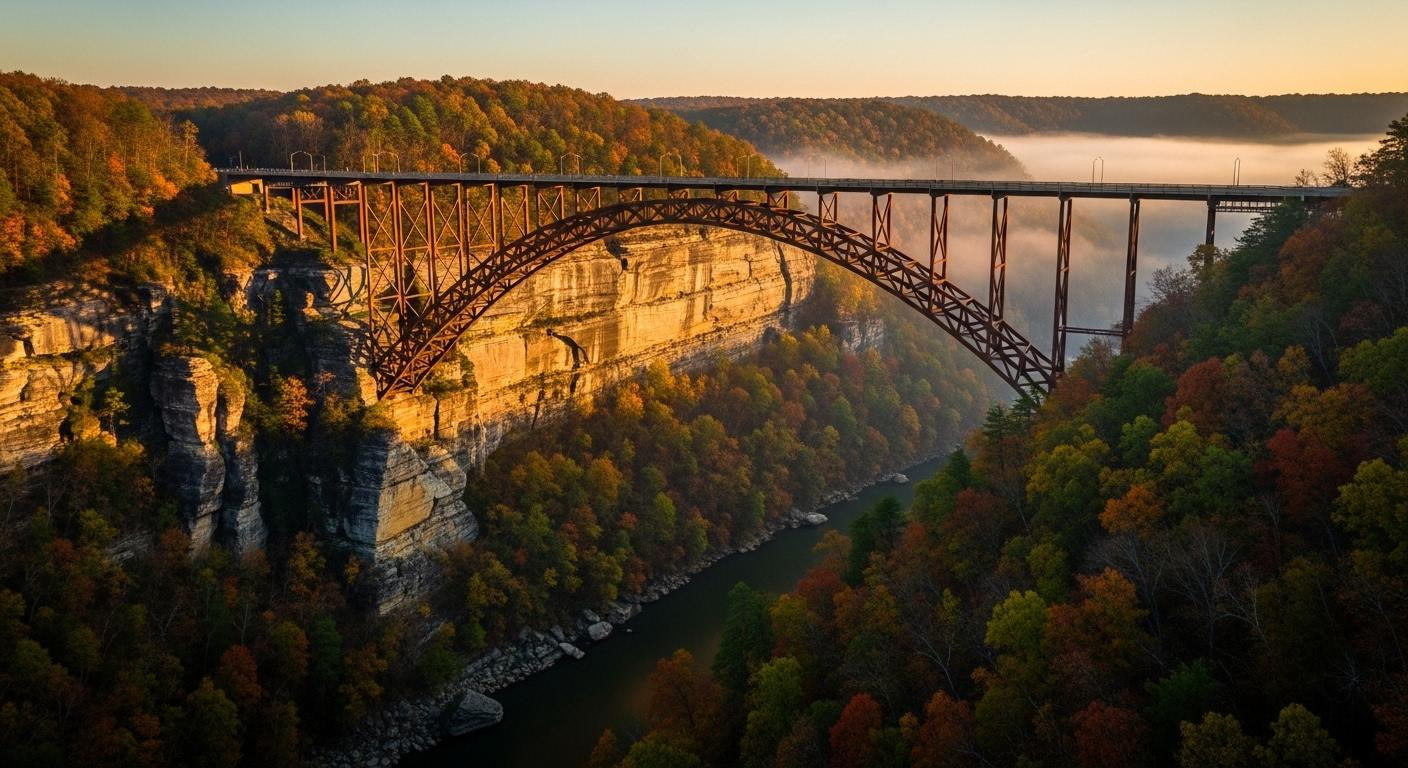Dawn breaks at 6:47 AM along the New River Gorge rim in November 2025. Mist rises from the river 876 feet below while the massive steel bridge emerges from fog like a rust-colored dream suspended impossibly in air. Three hours before climbers arrive at Endless Wall, America’s newest national park reveals what 1.8 million annual visitors still overlook: 72,000 acres of Appalachian wilderness where coal mining ruins blend into forest and adventure costs 20% less than Western parks.
The park that hides 200 miles from Washington DC
New River Gorge National Park and Preserve became America’s 63rd national park in December 2020. Yet most travelers don’t know it exists. Located in southern West Virginia’s Appalachian Mountains, the park protects 53 miles of the New River, paradoxically one of Earth’s oldest rivers despite its name.
The gorge drops 900 feet below surrounding plateaus. Ancient sandstone carved over 300 million years creates this geological masterpiece. Charleston’s Yeager Airport sits just 45 miles away, while Washington DC lies four hours by car through similar valley geography.
This accessibility secret keeps visitation modest at 1.8 million annually. Shenandoah draws 1.5 million visitors to smaller terrain. New River Gorge offers superior climbing routes and rafting conditions with genuine solitude.
Where industrial ruins meet wild Appalachia
What makes this gorge different
The New River Gorge Bridge defines the park’s visual identity. A 3,030-foot steel arch span suspended 876 feet above the river, completed in 1977 as a National Historic Landmark. Standing beneath it during the Bridge Walk experience reveals impossible scale. Wind rushes through the 1,700-foot gap while the river flows far below.
Kaymoor Mine ruins tell 150 years of coal mining history. Tipples and conveyors now rust peacefully into forest. This industrial-to-wilderness transformation distinguishes New River Gorge from pristine Western parks. Unlike overcrowded valley destinations, authentic heritage remains visible.
The forgotten geography
At 650 feet elevation along the gorge floor, sandstone cliffs rise 900 feet through rust-red and golden layers. Winter exposes 100 miles of trails and hidden waterfalls obscured by summer foliage. November temperatures hover between 50-75°F, ideal for hiking without crowds or humidity.
Morning light filters through leafless trees, casting long shadows on ancient rock. The soundscape includes rustling leaves, distant train horns echoing through the gorge, and gentle river roar below.
Adventure without Western park prices
Rock climbing and whitewater paradise
New River Gorge rivals Colorado’s climbing destinations with 1,400 established routes across cliffs. Routes range from beginner-friendly to expert-level challenges. Half-day guided climbing lessons cost $100-150, substantially below Western equivalents. Local climbing guides with decades of experience lead most sessions.
The New River offers Class III-V whitewater rafting through 53 miles of protected corridor. Trips run $75-120 per person depending on season and length. October brings peak fall foliage while winter reveals geological details summer hides.
Authentic Appalachian culture
Fayetteville, three miles from the bridge, maintains working-class authenticity while supporting outdoor recreation. Local dining averages $12-20 per meal featuring Appalachian specialties. Pepperoni rolls, ramps, and locally-sourced trout appear on most menus alongside craft brewery selections.
Accommodation ranges from $40 campgrounds to $200 boutique lodges. This pricing runs 15-20% below national park averages. Tourist spending increased 12% in 2024 to $108 million, supporting local communities without overwhelming them.
The November transformation
November strips away summer’s obscuring foliage, revealing the gorge’s true architecture. Waterfalls emerge from bare cliffs like silver ribbons. Sandstone layers glow amber in low-angle light. The Bridge Walk continues through winter with stronger wind, sharper views, and vanished crowds.
According to regional tourism data from 2025, winter visitation offers unobstructed views that reveal overlooked park features. Winter’s solitude feels profound here, where industrial history and wild nature coexist in rare balance. Early morning visits provide the most authentic experience.
Your questions about New River Gorge National Park and Preserve answered
How do you actually get there and what does it cost?
Charleston’s Yeager Airport sits 45 miles away with one-hour driving time. Washington DC requires four hours by car. Flights from NYC or Chicago range $150-350 round trip while car rentals average $60-90 daily. The Bridge Walk costs $72 per person. Guided climbing runs $100-150 and rafting trips cost $75-120. Total daily costs average 15-20% below Western national parks.
What makes the local culture authentic?
Fayetteville and surrounding towns preserve Appalachian heritage through pepperoni rolls, ramp festivals, and handmade crafts. Local business owners confirm that tourism has transformed the economy while preserving mountain culture authenticity. Visitors encounter genuine working-class communities, not manufactured tourist experiences. Coal mining heritage interpretation appears throughout the park.
How does it compare to Shenandoah or Red River Gorge?
New River Gorge attracts 1.8 million visitors versus Shenandoah’s 1.5 million, offering superior climbing with 1,400 routes and comparable hiking at lower costs. Red River Gorge in Kentucky provides similar climbing but lacks national park infrastructure and whitewater rafting. New River Gorge balances adventure sports, cultural depth, and accessibility better than either alternative.
At 5:47 PM, golden light touches rust-colored steel while the New River catches amber reflections 876 feet below. Steam rises from evening coffee in Fayetteville as climbers descend Endless Wall’s final pitches. This is America’s overlooked national park, where industrial scars heal into wilderness and adventure remains refreshingly authentic.
